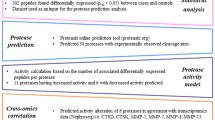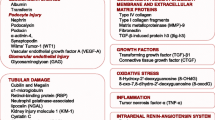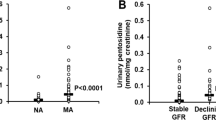Abstract
Background
To protect the kidney effectively with medication in type 2 diabetics, it is crucial to identify such at-risk patients early for treatment. We investigated whether peptiduria precedes proteinuria (the earliest urinary marker in our model), and thereby serve as an early predictor of diabetic nephropathy.
Methods
A longitudinal study was performed in a rat model of diabetic nephropathy. Peptides, defined as degradation products of proteins of < 13 kD size, were quantified by a previously validated method using a combination of Lowry and Biorad protein assays. Peptides in urine were also confirmed by chromatographically separating low molecular weight fractions from urine and quantifying albumin fragments in these fractions by enzyme immunoassay. Also, the mechanism of peptiduria was addressed by measuring acid phosphatase, a marker of lysosomal activity, in urine and on kidney sections (histochemically).
Results
In rats with diabetic nephropathy, proteinuria occurred after 12 weeks of diabetes, while peptiduria occurred as early as 2 weeks after diabetes. Peptiduria was confirmed by showing that the chromatographically separated low molecular weight fractions of urine containing albumin fragments is in proportion to the level of peptiduria. The time course of peptiduria paralleled the increase in urinary acid phosphatase suggesting that the mechanism of early peptiduria could be due to upregulation of lysosomal enzyme activity in the tubules.
Conclusions
Our results showing that peptiduria precedes proteinuria in diabetic nephropathy provide a compelling rationale to perform a prospective human clinical trial to investigate whether peptiduria can serve as an early predictor of diabetic nephropathy.





Similar content being viewed by others
References
Wild S, Roglic G, Green A, King H. Global prevalence of diabetes: estimates for the year 2000 and projections for 2013. Diabetes Care. 2004;27:1047–53.
McKay S and TODAY Study Group: rapid rise in hypertension and nephropathy in youth with type 2 diabetes. Diabetes Care. 2013;36:1735–41.
Retnakaran R, Cull CA, Thorne KI, Adler AI, Holman RR, UKPDS Study Group. Risk factors for type 2 diabetes: UK prospective diabetes study 74. Diabetes. 2006;55:1832–9.
Dronavalli S, Duka I, Bakris GL. The pathogenesis of diabetic nephropathy. Nat Clin Pract Endocrinol Metab. 2008;4:444–52.
American Diabetes Association. Standards of medical care in diabetes—2013. Diabetes Care. 2013;36(Suppl 1):511–66.
Johnson SA, Spurney RF. Twenty years after ACEIs and ARBs: emerging treatment strategies for diabetic nephropathy. Am J Physiol Renal Physiol. 2015;309:F807–20.
Parving HH, Noer I, Deckert T, Evrin PE, Nielsen SL, Lyngose J, Mogensen CE, Rorth M, Svendsen PA, Trap-Jensen J, Lassen NA. The effect of metabolic regulation on microvascular permeability to small and large molecules in short-term juvenile diabetes. Diabetologia. 1976;12:161–6.
Tucker BJ, Rasch R, Blantz RC. Glomerular filtration and tubular reabsorption of albumin in preproteinuric and proteinuric diabetic rats. J Clin Investig. 1993;92:686–94.
Gudehithlu KP, Pegoraro AA, Dunea G, Arruda JAL, Singh AK. Degradation of albumin by the renal proximal tubule cell and the subsequent fate of its fragments. Kidney Int. 2004;65:2113–22.
Singh AK, Gudehithlu KP, Gigi L, Litbarg NO, Khalili V, Hart P, Varnik J, Arruda JAL, Dunea G. Decreased urinary peptide excretion in patients with renal disease. Am J Kid Dis. 2004;44:1031–8.
Jefferson JA, Shankland SJ, Pichler RH. Proteinuria in diabetic kidney disease: a mechanistic viewpoint. Kidney Int. 2008;74:22–36.
Bradford MM. A rapid and sensitive method for the quantitation of microgram quantities of proteins utilizing the principle of protein-dye binding. Anal Biochem. 1976;72:248–54.
Lowry OH, Rosenbrough NJ, Farr AI, Randall RT. Protein measurement with the Folin-phenol reagent. J Biol Chem. 1951;193:265–75.
Lodish H, Beck A, Kaiser CA, Krieger M, Scott MP, Bretscher A, Ploegh H, Matsudaira P. Chapter 3. Protein structure and function. In: Lodish H, editor. Molecular cell biology. 6th ed. New York: WH Freeman and Co, 2008, pp. 84–85.
Koeppen B, Giebisch G, Malic G. Mechansim and regulation of renal tubular acidification. In: Seldin DW, Giebisch G, editors. The kidney: physiology and pathophysiology. New York: Raven Press; 1985. pp. 1491–525.
Christensen EI, Birn H. Megalin and cublin: multifunctional endocyric receptors. Nat Rev Mol Cell Biol. 2002;3:258–68.
Gekle M. Renal tubule albumin transport. Annu Rev Physiol. 2005;67:573–94.
Kimura T, Isaka Y, Yoshimori T. Autophagy and kidney inflammation. Autophagy. 2017;13:997–1003.
Good DM, Zürbig P, Argilés A, Bauer HW, Behrens G, Coon JJ, Dakna M, Decramer S, Delles C, Dominiczak AF, Ehrich JH, Eitner F, Fliser D, Frommberger M, Ganser A, Girolami MA, Golovko I, Gwinner W, Haubitz M, Herget-Rosenthal S, Jankowski J, Jahn H, Jerums G, Julian BA, Kellmann M, Kliem V, Kolch W, Krolewski AS, Luppi M, Massy Z, Melter M, Neusüss C, Novak J, Peter K, Rossing K, Rupprecht H, Schanstra JP, Schiffer E, Stolzenburg JU, Tarnow L, Theodorescu D, Thongboonkerd V, Vanholder R, Weissinger EM, Mischak H, Schmitt-Kopplin P. Naturally occurring human urinary peptides for use in diagnosis of chronic kidney disease. Mol Cell Proteom. 2010;9:2424–37.
Klein J, Bascands J-L, Mischak H, Schanstra JP. The role of urinary peptidomics in kidney disease research. Kidney Int. 2016;89:539–45.
Roscioni SS, de Zeeuw D, Hellemons ME, Mischak H, Zürbig P, Bakker SJL, Gansevoort RT, Reinhard H, Persson F, Lajer F, Rossing M, Lambers P, Heerspink HJ. A urinary peptide biomarker set predicts worsening of albuminuria in type 2 diabetes mellitus. Diabetologia. 2013;56:259–67.
Zürbig P, Jerums G, Hovind P, MacIsaac RJ, Mischak H, Nielsen SE, Panagiotopoulos S, Persson F, Rossing P. Urinary proteomics for early diagnosis in diabetic nephropathy. Diabetes. 2012;61:3304–13.
Acknowledgements
The authors wish to acknowledge the technical help of Dr. Lev Rappoport and Ms. Anu Hakimiyan for histological processing of tissues.
Funding
Financial support for the work was from Hektoen Institute for Medicine, Chicago IL (Grant no. 1994-00107).
Author information
Authors and Affiliations
Contributions
I hereby agree that all the authors read the manuscript and agreed with the content.
Corresponding author
Ethics declarations
Conflict of interest
The authors declare that they have no competing interest.
Electronic supplementary material
Below is the link to the electronic supplementary material.
About this article
Cite this article
Gudehithlu, K.P., Hart, P.D., Vernik, J. et al. Peptiduria: a potential early predictor of diabetic kidney disease. Clin Exp Nephrol 23, 56–64 (2019). https://doi.org/10.1007/s10157-018-1620-0
Received:
Accepted:
Published:
Issue Date:
DOI: https://doi.org/10.1007/s10157-018-1620-0




